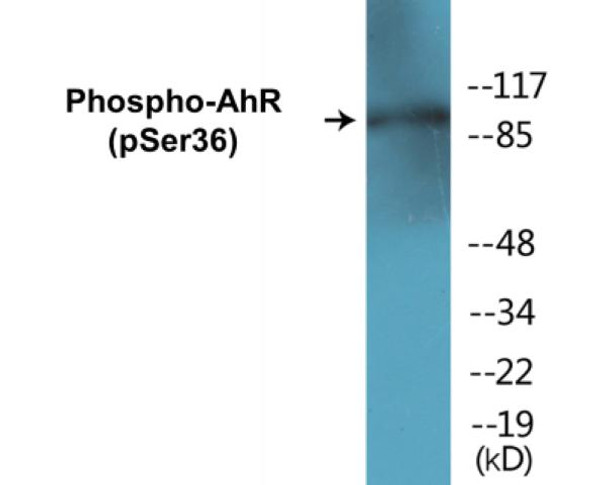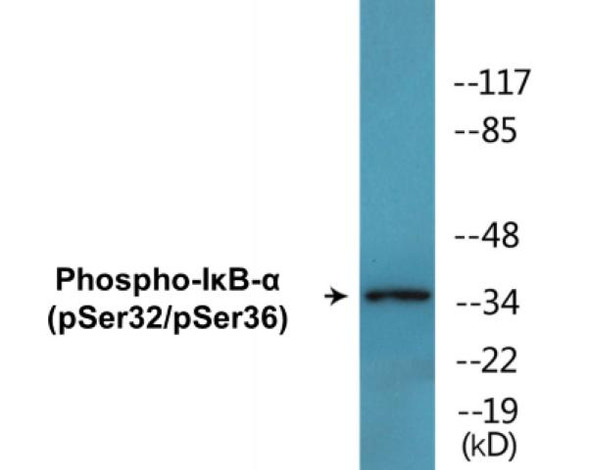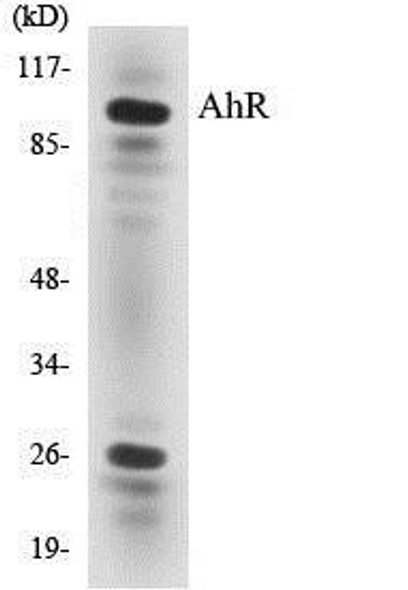Description
AhR (Phospho-Ser36)Colorimetric Cell-Based ELISA Kit
The AHR Phospho-Ser36 Colorimetric Cell-Based ELISA Kit is a convenient and reliable tool for the detection of phosphorylated AHR protein at Serine 36 in cell lysates. This kit offers high sensitivity and accuracy, allowing for precise measurements of AHR activation levels in response to various stimuli.The Aryl hydrocarbon receptor (AHR) is a ligand-activated transcription factor that plays a crucial role in the regulation of gene expression in response to environmental toxins and endogenous ligands. Phosphorylation of AHR at Serine 36 is a key post-translational modification that modulates its activity and stability, making it an important marker for studying AHR signaling pathways.
This kit is suitable for a wide range of cell-based assays and drug screening studies, providing researchers with valuable insights into the mechanisms underlying AHR activation and its implications in various diseases, including cancer, immune disorders, and metabolic syndromes. With its user-friendly protocol and robust performance, the AHR Phospho-Ser36 Colorimetric Cell-Based ELISA Kit is a valuable tool for advancing research in the field of molecular biology and drug discovery.
| Product Name: | AhR (Phospho-Ser36) Colorimetric Cell-Based ELISA |
| Product Code: | CBCAB00437 |
| ELISA Type: | Cell-Based |
| Target: | AhR (Phospho-Ser36) |
| Reactivity: | Human, Mouse, Rat |
| Dynamic Range: | > 5000 Cells |
| Detection Method: | Colorimetric 450 nm |
| Format: | 2 x 96-Well Microplates |
The AhR (Phospho-Ser36) Colorimetric Cell-Based ELISA Kit is a convenient, lysate-free, high throughput and sensitive assay kit that can detect AhR protein phosphorylation and expression profile in cells. The kit can be used for measuring the relative amounts of phosphorylated AhR in cultured cells as well as screening for the effects that various treatments, inhibitors (ie. siRNA or chemicals), or activators have on AhR phosphorylation.
Qualitative determination of AhR (Phospho-Ser36) concentration is achieved by an indirect ELISA format. In essence, AhR (Phospho-Ser36) is captured by AhR (Phospho-Ser36)-specific primary antibodies while the HRP-conjugated secondary antibodies bind the Fc region of the primary antibody. Through this binding, the HRP enzyme conjugated to the secondary antibody can catalyze a colorimetric reaction upon substrate addition. Due to the qualitative nature of the Cell-Based ELISA, multiple normalization methods are needed:
| 1. | A monoclonal antibody specific for human GAPDH is included to serve as an internal positive control in normalizing the target absorbance values. |
| 2. | Following the colorimetric measurement of HRP activity via substrate addition, the Crystal Violet whole-cell staining method may be used to determine cell density. After staining, the results can be analysed by normalizing the absorbance values to cell amounts, by which the plating difference can be adjusted. |
| Database Information: | Gene ID: 196/57491, UniProt ID: P35869/A9YTQ3, OMIM: 600253/606517, Unigene: Hs.171189/Hs.50823 |
| Gene Symbol: | AHR |
| Sub Type: | Phospho |
| UniProt Protein Function: | AHR: a nuclear receptor for aryl hydrocarbons involved in xenobiotic metabolism, cell cycle regulation, and development in response to both endogenous and environmental signals. AhR was initially identified as a receptor for dioxins, which are environmental pollutants generated by waste incineration and other industrial processes. AhR ligands include polycyclic aromatic hydrocarbons, including the carcinogen benzo(a)pyrene and other components of cigarette smoke. Naturally occurring AhR ligands include flavonoids, which are aromatic plant secondary compounds commonly found in vegetables and fruits. Cytoplasmic aryl hydrocarbon receptors are found in protein complexes with heat shock proteins. Upon ligand binding, AhR dissociates from heat shock proteins and translocate to the nucleus where it dimerizes with AhR nuclear translocator (ARNT, HIF-1b). The AhR/ARNT heterodimer binds to nuclear xenobiotic response elements to control the expression of genes associated with xenobiotic metabolism, including several cytochrome P450 genes. AhR is ubiquitously expressed and is thought to play a role in regulation of cell proliferation and differentiation, cytokine expression, and xenobiotic metabolism. Research studies link AhR activity with the control of regulatory T-cell and T-helper 17 cell differentiation, regulation of the inflammatory response, and the onset of lung cancer. |
| UniProt Protein Details: | Protein type:DNA-binding; Transcription factor; Nuclear receptor Chromosomal Location of Human Ortholog: 7p15 Cellular Component: nucleoplasm; transcription factor complex; cytoplasm; nucleus Molecular Function:protein dimerization activity; RNA polymerase II transcription factor activity, enhancer binding; ligand-dependent nuclear receptor activity; protein binding; signal transducer activity; DNA binding; sequence-specific DNA binding; protein heterodimerization activity; Hsp90 protein binding; transcription factor activity; transcription factor binding Biological Process: transcription from RNA polymerase II promoter; prostate gland development; blood vessel development; intracellular receptor-mediated signaling pathway; apoptosis; response to toxin; positive regulation of transcription, DNA-dependent; negative regulation of transcription from RNA polymerase II promoter; cell cycle; regulation of transcription from RNA polymerase II promoter; response to xenobiotic stimulus; regulation of transcription, DNA-dependent; regulation of gene expression; xenobiotic metabolic process; regulation of B cell proliferation; positive regulation of transcription from RNA polymerase II promoter; circadian regulation of gene expression; negative regulation of transcription, DNA-dependent; positive regulation of transcriptional preinitiation complex assembly |
| NCBI Summary: | This gene encodes a ligand-activated transcription factor involved in the regulation of biological responses to planar aromatic hydrocarbons. This receptor has been shown to regulate xenobiotic-metabolizing enzymes such as cytochrome P450. Its ligands included a variety of aromatic hydrocarbons. [provided by RefSeq, Jul 2008] |
| UniProt Code: | P35869 |
| NCBI GenInfo Identifier: | 3041653 |
| NCBI Gene ID: | 196 |
| NCBI Accession: | P35869.2 |
| UniProt Secondary Accession: | P35869,Q13728, Q13803, Q13804, A4D130, |
| UniProt Related Accession: | P35869 |
| Molecular Weight: | 848 |
| NCBI Full Name: | Aryl hydrocarbon receptor |
| NCBI Synonym Full Names: | aryl hydrocarbon receptor |
| NCBI Official Symbol: | AHR |
| NCBI Official Synonym Symbols: | bHLHe76 |
| NCBI Protein Information: | aryl hydrocarbon receptor; AH-receptor; ah receptor; aromatic hydrocarbon receptor; class E basic helix-loop-helix protein 76 |
| UniProt Protein Name: | Aryl hydrocarbon receptor |
| UniProt Synonym Protein Names: | Class E basic helix-loop-helix protein 76; bHLHe76 |
| Protein Family: | Aldehyde reductase |
| UniProt Gene Name: | AHR |
| UniProt Entry Name: | AHR_HUMAN |
| Component | Quantity |
| 96-Well Cell Culture Clear-Bottom Microplate | 2 plates |
| 10X TBS | 24 mL |
| Quenching Buffer | 24 mL |
| Blocking Buffer | 50 mL |
| 15X Wash Buffer | 50 mL |
| Primary Antibody Diluent | 12 mL |
| 100x Anti-Phospho Target Antibody | 60 µL |
| 100x Anti-Target Antibody | 60 µL |
| Anti-GAPDH Antibody | 60 µL |
| HRP-Conjugated Anti-Rabbit IgG Antibody | 12 mL |
| HRP-Conjugated Anti-Mouse IgG Antibody | 12 mL |
| SDS Solution | 12 mL |
| Stop Solution | 24 mL |
| Ready-to-Use Substrate | 12 mL |
| Crystal Violet Solution | 12 mL |
| Adhesive Plate Seals | 2 seals |
The following materials and/or equipment are NOT provided in this kit but are necessary to successfully conduct the experiment:
- Microplate reader able to measure absorbance at 450 nm and/or 595 nm for Crystal Violet Cell Staining (Optional)
- Micropipettes with capability of measuring volumes ranging from 1 µL to 1 ml
- 37% formaldehyde (Sigma Cat# F-8775) or formaldehyde from other sources
- Squirt bottle, manifold dispenser, multichannel pipette reservoir or automated microplate washer
- Graph paper or computer software capable of generating or displaying logarithmic functions
- Absorbent papers or vacuum aspirator
- Test tubes or microfuge tubes capable of storing ≥1 ml
- Poly-L-Lysine (Sigma Cat# P4832 for suspension cells)
- Orbital shaker (optional)
- Deionized or sterile water
*Note: Protocols are specific to each batch/lot. For the correct instructions please follow the protocol included in your kit.
| Step | Procedure |
| 1. | Seed 200 µL of 20,000 adherent cells in culture medium in each well of a 96-well plate. The plates included in the kit are sterile and treated for cell culture. For suspension cells and loosely attached cells, coat the plates with 100 µL of 10 µg/ml Poly-L-Lysine (not included) to each well of a 96-well plate for 30 minutes at 37°C prior to adding cells. |
| 2. | Incubate the cells for overnight at 37°C, 5% CO2. |
| 3. | Treat the cells as desired. |
| 4. | Remove the cell culture medium and rinse with 200 µL of 1x TBS, twice. |
| 5. | Fix the cells by incubating with 100 µL of Fixing Solution for 20 minutes at room temperature. The 4% formaldehyde is used for adherent cells and 8% formaldehyde is used for suspension cells and loosely attached cells. |
| 6. | Remove the Fixing Solution and wash the plate 3 times with 200 µL 1x Wash Buffer for five minutes each time with gentle shaking on the orbital shaker. The plate can be stored at 4°C for a week. |
| 7. | Add 100 µL of Quenching Buffer and incubate for 20 minutes at room temperature. |
| 8. | Wash the plate 3 times with 1x Wash Buffer for 5 minutes each time. |
| 9. | Add 200 µL of Blocking Buffer and incubate for 1 hour at room temperature. |
| 10. | Wash 3 times with 200 µL of 1x Wash Buffer for 5 minutes each time. |
| 11. | Add 50 µL of 1x primary antibodies Anti-AhR (Phospho-Ser36) Antibody, Anti-AhR Antibody and/or Anti-GAPDH Antibody) to the corresponding wells, cover with Parafilm and incubate for 16 hours (overnight) at 4°C. If the target expression is known to be high, incubate for 2 hours at room temperature. |
| 12. | Wash 3 times with 200 µL of 1x Wash Buffer for 5 minutes each time. |
| 13. | Add 50 µL of 1x secondary antibodies (HRP-Conjugated AntiRabbit IgG Antibody or HRP-Conjugated Anti-Mouse IgG Antibody) to corresponding wells and incubate for 1.5 hours at room temperature. |
| 14. | Wash 3 times with 200 µL of 1x Wash Buffer for 5 minutes each time. |
| 15. | Add 50 µL of Ready-to-Use Substrate to each well and incubate for 30 minutes at room temperature in the dark. |
| 16. | Add 50 µL of Stop Solution to each well and read OD at 450 nm immediately using the microplate reader. |
(Additional Crystal Violet staining may be performed if desired – details of this may be found in the kit technical manual.)






